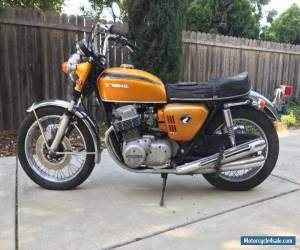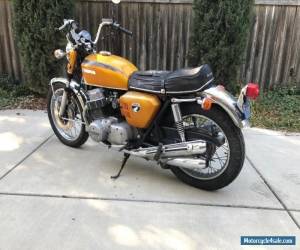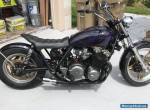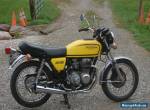 »
Motorcycles for sale in USA » Honda » CB » 1970 Honda CB
»
Motorcycles for sale in USA » Honda » CB » 1970 Honda CB
1970 Honda CB
$US 6,000.00
Make an offer
| Motorcycle location: |
Sacramento, California, United States |
| Sale type: | owner |
| Last update: | 27.09.2017 |
WARNING! BEWARE OF SCAMMERS!
MOTORCYCLE4SALE DOESN'T TAKE ANY RESPONSIBILITY FOR ANY SCAM ACTION.
BUY RESPONSIBLY!
Technical specifications, photos and description:



| Condition: | Used |
| Year: | 1970 |
| Mileage: | 22,617 |
| Exterior Color: | Candy |
| Manufacturer: | Honda |
| Engine Size (cc): | 750 |
| Model: | CB |
| Warranty: | no |
| Sub Model (Optional): | CB750 |
| Vehicle Title: | Clear |
| Type: | Caf?� Racer |
| Got questions? | Ask here! |
1970 Honda CB for sale
Up for sale XXXX/XXXX Honda CB XXX project rare barn find. The motorcycle was sitting for last XX years inside of the barn in California. Last time it ran was in XXXX. Motorcycle is XXX% complete. Please look at pictures ask questions!!!
We reserve right to end auction if we get good offer!!!
Little bit of history!!!
Honda of Japan introduced the CBXXX motorcycle to the US and European markets in XXXX after experiencing success with its smaller motorcycles. In the late XXXXs Honda motorcycles were, overall, the world's biggest sellers. There were the CXXX Cub step-through-the best-selling motorcycle of all time-the CXX, CXX, CXX and CAXX/X Dreams; and the CBXX/XX Super Hawks/Sports. taste of what was ahead came with the introduction of the revolutionary CBXXX DOHC twin-cylinder machine in XXXX. Profits from these production bikes financed the successful racing machines of the XXXXs, and lessons learned from racing were applied to the CBXXX. The CBXXX was targeted directly at the US market after Honda officials, including founder Soichiro Honda, repeatedly met US dealers and understood the opportunity for larger bike.
Early racing EditIn XXXX American Honda's service manager Bob Hansen[XX][XX] flew to Japan and discussed with Soichiro Honda the possibility of using Grand Prix technology in bikes prepared for American motorcycle events. American racing's governing body, the AMA, had rules that allowed racing by production machines only, and restricted overhead-valve engines to XXX cc whilst allowing the side-valve Harley Davidsons to compete with XXX cc engines.[XX] Honda knew that what won on the race track today, sold in the show rooms tomorrow, and large engine capacity road machine would have to be built to compete with the Harley Davidson and Triumph twin-cylinder machines.
Hansen told Soichiro Honda that he should build 'King of Motorcycles' and the CBXXX appeared at the Tokyo Show in November, XXXX[XX] and was publicly launched in UK at the Brighton, England motorcycle show held at the Metropole Hotel exhibition centre during April XXXX,[XX][XX] with an earlier press-launch at Honda's London headquarters,[XX][XX] the pre-production versions appearing with high and very wide handlebar intended for the US market.[XX]
The AMA Competition Committee recognised the need for more variation of racing motorcycle and changed the rules from XXXX, by standardizing full XXX cc displacement for all engines regardless of valve location or number of cylinders, enabling Triumph and BSA to field their XXX cc triples instead of the XXX cc Triumph Daytona twins.[XX]
Dick Mann's Daytona-winning CRXXX on display at Le Mus?�e Auto Moto V?�lo, transportation Museum in Ch??tellerault, FranceThe Honda factory responded by producing four works-racer CRXXXs, racing version of the production CBXXX, ridden by UK-based Ralph Bryans, Tommy Robb and Bill Smith under the supervision of Mr Nakamura, and fourth machine under Hansen ridden by Dick Mann. The three Japanese-prepared machines all failed during the race with Mann just holding on to win by few seconds with failing engine.[XX]
Hansen's race team's historic victory at the March, XXXX Daytona XXX with Dick Mann riding tall-geared CRXXX to victory[X][XX] preceded the June, XXXX Isle of Man TT races when two 'official' Honda CBXXXs were entered, again ridden by Irishman Tommy Robb partnered in the team by experienced English racer John Cooper. The machines were entered into the XXX cc Production Class, category for road-based machines allowing limited number of strictly-controlled modifications. They finished in eighth and ninth places.[XX] Cooper was interviewed in UK monthly magazine Motorcycle Mechanics, stating both riders were unhappy with their poor-handling Hondas, and that he would not ride in the next year's race "unless the bikes have been greatly improved".[XX]
In XXXX, Japanese rider Morio Sumiya finished in sixth place in the Daytona XXX-Mile race on factory XXX.
Other Honda motorcycles offered via internet auctions:
© 2015 Motorcycle4Sale.com

